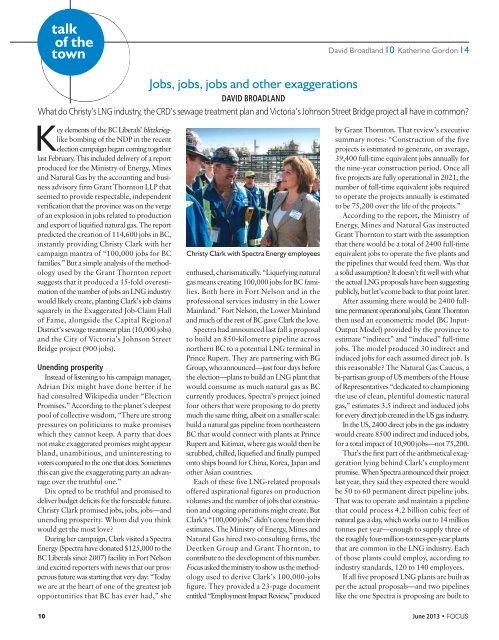***Mar 2006 Focus pg 1-32 - Focus Magazine
***Mar 2006 Focus pg 1-32 - Focus Magazine
***Mar 2006 Focus pg 1-32 - Focus Magazine
Create successful ePaper yourself
Turn your PDF publications into a flip-book with our unique Google optimized e-Paper software.
talkof thetownDavid Broadland10 Katherine Gordon14Jobs, jobs, jobs and other exaggerationsDAVID BROADLANDWhat do Christy’s LNG industry, the CRD’s sewage treatment plan and Victoria’s Johnson Street Bridge project all have in common?Key elements of the BC Liberals’ blitzkrieglikebombing of the NDP in the recentelection campaign began coming togetherlast February. This included delivery of a reportproduced for the Ministry of Energy, Minesand Natural Gas by the accounting and businessadvisory firm Grant Thornton LLP thatseemed to provide respectable, independentverification that the province was on the vergeof an explosion in jobs related to productionand export of liquified natural gas. The reportpredicted the creation of 114,600 jobs in BC,instantly providing Christy Clark with hercampaign mantra of “100,000 jobs for BCfamilies.” But a simple analysis of the methodologyused by the Grant Thornton reportsuggests that it produced a 15-fold overestimationof the number of jobs an LNG industrywould likely create, planting Clark’s job claimssquarely in the Exaggerated Job-Claim Hallof Fame, alongside the Capital RegionalDistrict’s sewage treatment plan (10,000 jobs)and the City of Victoria’s Johnson StreetBridge project (900 jobs).Unending prosperityInstead of listening to his campaign manager,Adrian Dix might have done better if hehad consulted Wikipedia under “ElectionPromises.” According to the planet’s deepestpool of collective wisdom, “There are strongpressures on politicians to make promiseswhich they cannot keep. A party that doesnot make exaggerated promises might appearbland, unambitious, and uninteresting tovoters compared to the one that does. Sometimesthis can give the exaggerating party an advantageover the truthful one.”Dix opted to be truthful and promised todeliver budget deficits for the forseeable future.Christy Clark promised jobs, jobs, jobs—andunending prosperity. Whom did you thinkwould get the most love?During her campaign, Clark visited a SpectraEnergy (Spectra have donated $125,000 to theBC Liberals since 2007) facility in Fort Nelsonand excited reporters with news that our prosperousfuture was starting that very day: “Todaywe are at the heart of one of the greatest jobopportunities that BC has ever had,” sheChristy Clark with Spectra Energy employeesenthused, charismatically. “Liquefying naturalgas means creating 100,000 jobs for BC families.Both here in Fort Nelson and in theprofessional services industry in the LowerMainland.” Fort Nelson, the Lower Mainlandand much of the rest of BC gave Clark the love.Spectra had announced last fall a proposalto build an 850-kilometre pipeline acrossnorthern BC to a potential LNG terminal inPrince Rupert. They are partnering with BGGroup, who announced—just four days beforethe election—plans to build an LNG plant thatwould consume as much natural gas as BCcurrently produces. Spectra’s project joinedfour others that were proposing to do prettymuch the same thing, albeit on a smaller scale:build a natural gas pipeline from northeasternBC that would connect with plants at PrinceRupert and Kitimat, where gas would then bescrubbed, chilled, liquefied and finally pumpedonto ships bound for China, Korea, Japan andother Asian countries.Each of these five LNG-related proposalsoffered aspirational figures on productionvolumes and the number of jobs that constructionand ongoing operations might create. ButClark’s “100,000 jobs” didn’t come from theirestimates. The Ministry of Energy, Mines andNatural Gas hired two consulting firms, theDeetken Group and Grant Thornton, tocontribute to the development of this number.<strong>Focus</strong> asked the ministry to show us the methodologyused to derive Clark’s 100,000-jobsfigure. They provided a 23-page documententitled “Employment Impact Review,” producedby Grant Thornton. That review’s executivesummary notes: “Construction of the fiveprojects is estimated to generate, on average,39,400 full-time equivalent jobs annually forthe nine-year construction period. Once allfive projects are fully operational in 2021, thenumber of full-time equivalent jobs requiredto operate the projects annually is estimatedto be 75,200 over the life of the projects.”According to the report, the Ministry ofEnergy, Mines and Natural Gas instructedGrant Thornton to start with the assumptionthat there would be a total of 2400 full-timeequivalent jobs to operate the five plants andthe pipelines that would feed them. Was thata solid assumption? It doesn’t fit well with whatthe actual LNG proposals have been suggestingpublicly, but let’s come back to that point later.After assuming there would be 2400 fulltimepermanent operational jobs, Grant Thorntonthen used an econometric model (BC Input-Output Model) provided by the province toestimate “indirect” and “induced” full-timejobs. The model produced 30 indirect andinduced jobs for each assumed direct job. Isthis reasonable? The Natural Gas Caucus, abi-partisan group of US members of the Houseof Representatives “dedicated to championingthe use of clean, plentiful domestic naturalgas,” estimates 3.5 indirect and induced jobsfor every direct job created in the US gas industry.In the US, 2400 direct jobs in the gas industrywould create 8500 indirect and induced jobs,for a total impact of 10,900 jobs—not 75,200.That’s the first part of the arithmetical exaggerationlying behind Clark’s employmentpromise. When Spectra announced their projectlast year, they said they expected there wouldbe 50 to 60 permanent direct pipeline jobs.That was to operate and maintain a pipelinethat could process 4.2 billion cubic feet ofnatural gas a day, which works out to 14 milliontonnes per year—enough to supply three ofthe roughly four-million-tonnes-per-year plantsthat are common in the LNG industry. Eachof those plants could employ, according toindustry standards, 120 to 140 employees.If all five proposed LNG plants are built asper the actual proposals—and two pipelineslike the one Spectra is proposing are built to10 June 2013 • FOCUS
















